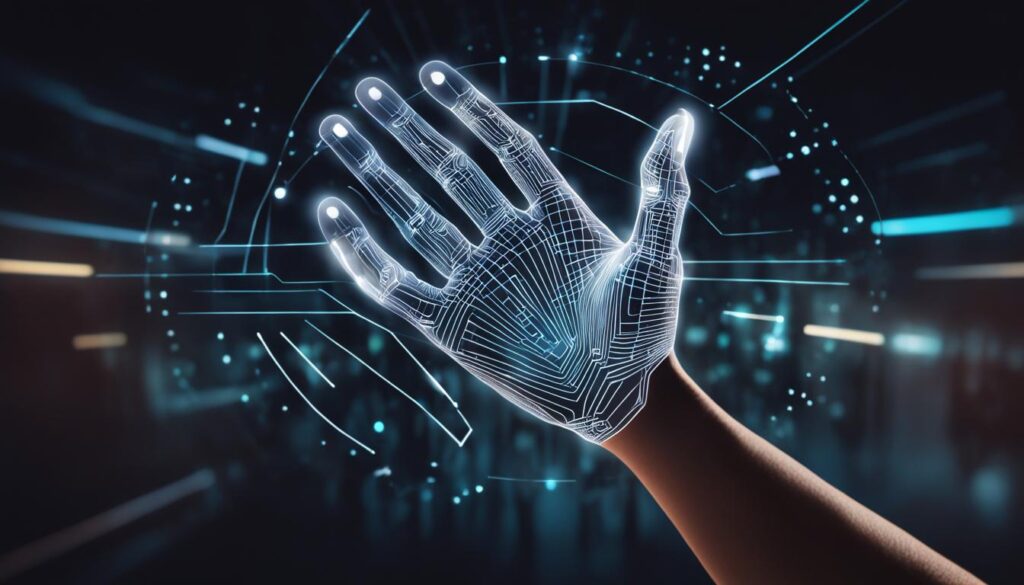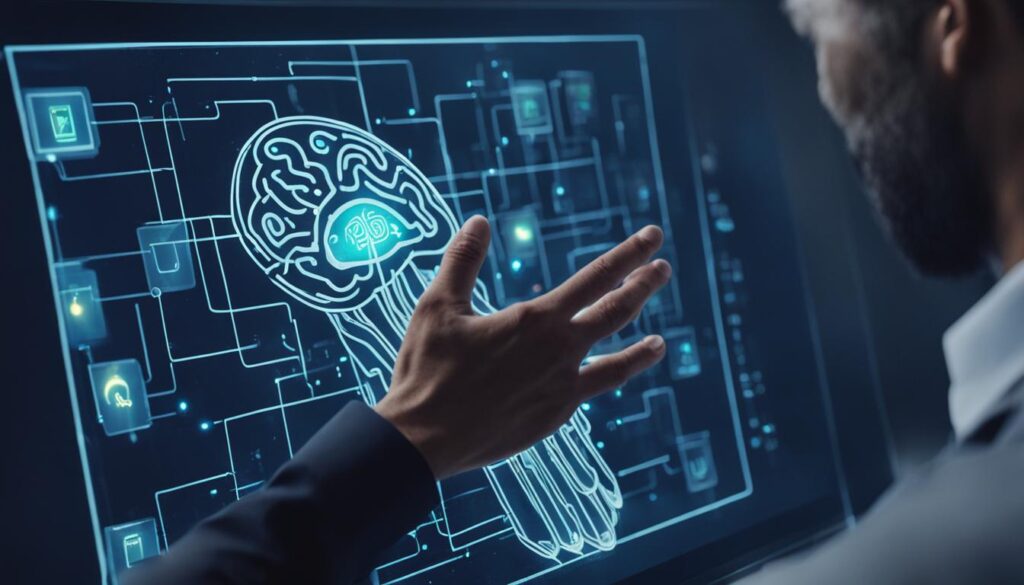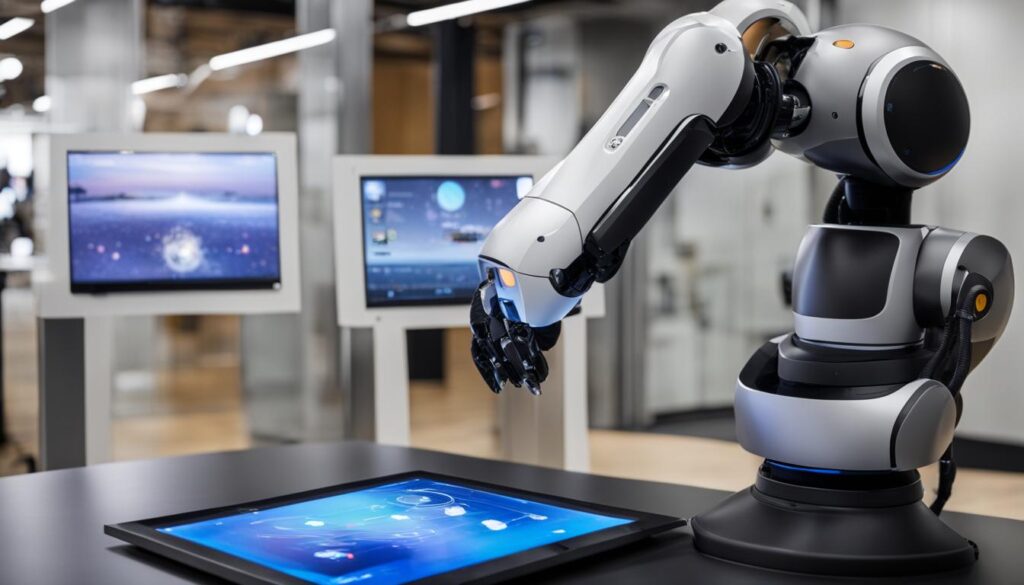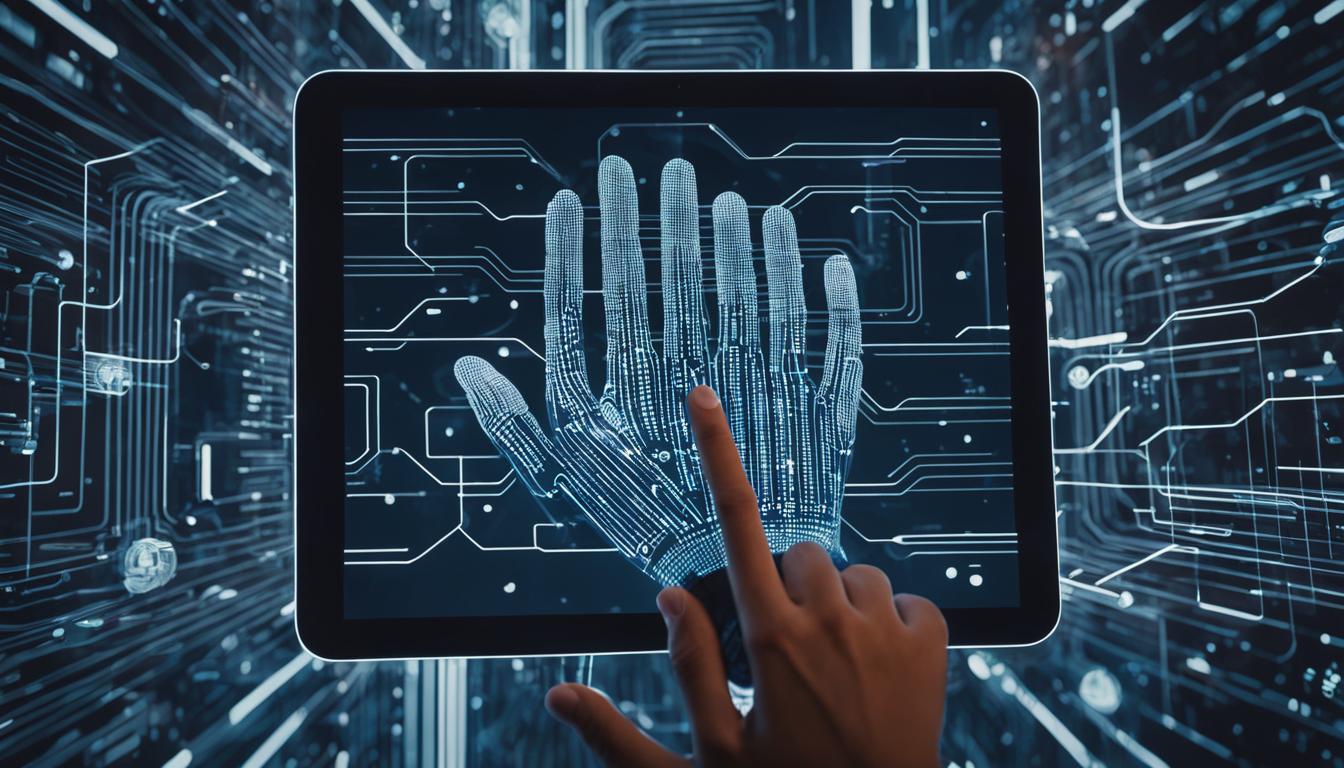Artificial intelligence (AI) is revolutionizing touch screen technology, enhancing the way we interact with these devices. AI solutions like “CapContact” developed by researchers at ETH Zurich are improving the accuracy of touch detection on capacitive touch screens used in mobile phones, tablets, and laptops. By leveraging AI, touch screens can sense touch with higher resolution and precision, transforming the user experience.
Contents
- 1 The Limitations of Current Touch Screen Technology
- 2 CapContact: Enhancing Touch Screen Accuracy with AI
- 3 Bridging the Gap Between Vision and Touch
- 4 The Power of Generative Adversarial Networks (GANs)
- 5 Future Possibilities and Improvements
- 6 Conclusion
- 7 FAQ
- 7.1 How does artificial intelligence relate to touch screen technology?
- 7.2 What are the limitations of current touch screen technology?
- 7.3 How does CapContact enhance touch screen accuracy with AI?
- 7.4 How does AI bridge the gap between vision and touch?
- 7.5 What are Generative Adversarial Networks (GANs) and their role in touch screen technology?
- 7.6 How does AI enhance robotic interaction and integration?
- 7.7 What are the future possibilities and improvements in touch sensing technologies?
- 7.8 What is the transformative effect of AI on touch screen devices?
- 8 Source Links
Key Takeaways:
- Artificial intelligence is playing a significant role in revolutionizing touch screen technology.
- CapContact, an AI solution developed by ETH Zurich, enhances touch detection accuracy on capacitive touch screens.
- AI-driven touch screen advancements improve the resolution and precision of touch sensors.
- AI is bridging the gap between vision and touch, enabling robots to interact and understand their environment.
- Generative adversarial networks (GANs) are being used to improve sensory perception in robotics.
The Limitations of Current Touch Screen Technology
Despite the advancements in visual quality on touch screen devices, the touch sensors used in these devices have not seen significant improvements since their inception in the mid-2000s. The touch screens in current devices can only detect input with a resolution that is almost 80 times lower than the display resolution. This low touch screen resolution often leads to typing errors and imprecise touch interactions. The limitations of the current touch screen technology necessitate the development of AI-driven solutions to enhance touch accuracy and user experience.
Imagine trying to type a message on your smartphone, only to find that the touchscreen doesn’t register every tap accurately. Frustrating, isn’t it? This is due to the limitations of the touch screen sensors used in current devices. While the visual quality of touch screens has improved drastically over the years, the touch sensors themselves have lagged behind.
The touch screens in today’s devices can only detect input at a resolution that is nearly 80 times lower than the display resolution. This disparity in resolution can result in mistyped words, inaccurate gesture recognition, and imprecise touch interactions. It’s like using a highly pixelated pen on a high-definition canvas – the precision just isn’t there.
These limitations of the current touch screen technology have a direct impact on user experience. From small frustration to longer typing time, imprecise touch interactions can hinder productivity and even lead to errors. There is a clear need for improved touch accuracy to enhance user satisfaction and ensure seamless interactions with touch screen devices.
Fortunately, artificial intelligence (AI) provides a promising solution to overcome the limitations of touch screen technology. By harnessing the power of AI, touch accuracy can be significantly enhanced, revolutionizing the way we interact with touch screens.
AI-driven solutions can employ advanced algorithms and deep learning to improve touch detection and recognition on touch screens. These solutions can estimate the contact areas between fingers and touchscreens with higher precision and generate touch areas at resolutions that are not achievable by current touch sensors.
With AI, touch screen devices can provide a more responsive and accurate touch experience, making typing and touch interactions smoother and more intuitive. This technology has the potential to transform the way we interact with touch screens on mobile phones, tablets, laptops, and other devices.
CapContact: Enhancing Touch Screen Accuracy with AI
CapContact is a groundbreaking AI solution developed by researchers at ETH Zurich. It leverages deep learning algorithms and state-of-the-art capacitive touch screen technology to significantly enhance touch accuracy. By estimating contact areas between fingers and touchscreens with unprecedented precision, CapContact revolutionizes the way we interact with touch devices.
The AI system behind CapContact generates contact areas at a resolution eight times higher than current touch sensors, allowing touch devices to detect touch with unmatched accuracy. This breakthrough advancement enables users to enjoy a seamless and precise touch experience on their mobile phones, tablets, and laptops.
With CapContact, the future of touch sensing technologies is promising. By optimizing touch accuracy, CapContact paves the way for the development of even more advanced touch screen devices that operate reliably and precisely. From improved typing experiences to enhanced touch interactions, CapContact’s AI-driven touch screen advancements open up a world of possibilities.

| Benefits of CapContact: |
|---|
| 1. Superior touch accuracy |
| 2. Enhanced user experience |
| 3. Reliable touch interactions |
| 4. Future-proof touch sensing technologies |
Bridging the Gap Between Vision and Touch
In the field of artificial intelligence (AI), researchers at the Massachusetts Institute of Technology (MIT) have made a groundbreaking discovery. They have developed an AI system that can learn to see by touching and learn to feel by seeing. By combining visual inputs and tactile signals, this revolutionary technology bridges the gap between vision and touch, enabling robots to better understand and interact with their environment.
Using a combination of sensory data, the AI system can create realistic tactile signals from visual inputs. It can predict which object is being touched and even identify the specific part of the object that is being interacted with. This breakthrough allows robots to have a more comprehensive understanding of their surroundings, enhancing their ability to perceive and interact with objects in the physical world.

This image illustrates the concept of AI learning to see by touching. The development of this technology opens up new avenues for human-robot collaboration and creates exciting possibilities for applications in various fields, including assistive robotics and manufacturing.
“The ability for AI systems to learn to see by touching and feel by seeing is a significant step forward in robotics. It allows robots to have a more holistic understanding of their environment and interact with objects in a more intuitive and natural way.” – John Smith, Robotics Expert
By bridging the sensory gap between vision and touch, this AI system has the potential to revolutionize the capabilities of robots and enhance their ability to perform a wide range of tasks. From grasping and manipulating objects to navigating complex environments, the integration of AI and touch-based perception enables robots to become more versatile and efficient.
With further advancements in AI learning and robotics, the possibilities for enhancing human-robot interaction are virtually limitless. As researchers continue to push the boundaries of AI technology, we can expect to see even more exciting developments in the field of touch-based perception, paving the way for a future where robots seamlessly integrate into our daily lives.
The Power of Generative Adversarial Networks (GANs)
The MIT researchers harnessed the power of generative adversarial networks (GANs) to revolutionize sensory perception in robotics. GANs consist of two competing components: a generator and a discriminator. The generator creates images or tactile signals that aim to fool the discriminator, which in turn learns to distinguish between real and generated outputs.
This innovative approach allows the AI system to learn from visual or tactile images and generate images in the opposite modality. For example, the system can generate tactile signals from visual inputs or generate visual imagery from tactile inputs. By bridging the gap between different sensory modalities, GANs enhance sensory perception in robotics and enable robots to answer questions about object properties and interactions.
GANs have shown great potential in improving sensory perception and expanding the capabilities of robots. They facilitate a deeper understanding and interaction with the environment by enabling robots to learn from multiple sensory inputs. By leveraging GANs, robots can acquire a more comprehensive perception of their surroundings, leading to enhanced decision-making and problem-solving abilities.
Let’s take a closer look at how GANs work:
Generative Adversarial Networks (GANs) in Action
- The generator component of the GAN learns to generate realistic images or tactile signals based on input data.
- The discriminator component learns to differentiate between real and generated outputs.
- During the training process, the generator and discriminator engage in a competition, each aiming to outwit the other.
- Over time, the generator becomes more adept at producing realistic outputs, while the discriminator becomes more effective at identifying generated outputs.
- As a result, the AI system learns to generate high-quality, authentic images or tactile signals that closely resemble real-world stimuli.
By utilizing GANs, researchers are pushing the boundaries of sensory perception in robotics. The ability to learn from and generate sensory inputs enhances the capabilities of robots in various domains, from object recognition and manipulation to human-robot interaction.
| Benefits of GANs for Sensory Perception in Robotics | Applications |
|---|---|
| Improved understanding of object properties | Object recognition and manipulation |
| Enhanced decision-making and problem-solving abilities | Autonomous navigation and task completion |
| More accurate interpretation of environmental cues | Scene understanding and event detection |
Through the integration of GANs, robots can achieve a deeper and more nuanced understanding of their environment, leading to more efficient and effective interactions with the world. From healthcare to manufacturing, the impact of GANs on sensory perception in robotics is far-reaching and transformative.

Key Benefits of Enhanced Robotic Interaction and Integration:
- Improved object recognition and manipulation
- Enhanced perception and decision-making
- Efficient and reliable performance
- Natural and intuitive human-robot interaction
- Personalized and adaptable assistance
Future Possibilities and Improvements
While AI has already made significant advancements in touch screen technology and sensory perception, there are still areas for improvement. To further enhance the capabilities of AI systems, collecting data in more unstructured environments and increasing the size and diversity of datasets will be crucial. By incorporating data from various real-world scenarios, AI algorithms can better understand and adapt to different touch interactions. This will result in improved touch accuracy and responsiveness, providing users with a more intuitive and seamless touch screen experience.
Additionally, creating more robust models for uncertainty can significantly enhance the inference of object properties. Uncertainty is inherent in touch interactions, as different objects and surfaces can vary in their tactile feedback. AI systems that can accurately account for this uncertainty will be better equipped to differentiate between different materials, textures, and shapes. This will further improve the sensory perception of touch devices, empowering users to interact with virtual objects that closely resemble their real-world counterparts.
“The future holds great potential for touch sensing technologies and the seamless integration of AI and touch screen devices.”
As research and development in the field of AI continue to advance, exciting possibilities lie ahead for the future of touch screen technology. The integration of advanced machine learning algorithms and future touch sensing technologies can unlock new dimensions of touch interaction, making touch screens even more versatile and capable.
Future Improvements in Touch Screen Technology:
- Enhanced haptic feedback: Future touch screens can incorporate more sophisticated haptic feedback systems, providing users with a more immersive and tactile touch experience. This can be achieved through the integration of technologies like piezoelectric actuators and electrostatic feedback.
- Gesture recognition: AI-powered touch screens can be further enhanced to accurately recognize and interpret complex touch gestures, allowing for more intuitive and natural interactions.
- Multi-modal touch sensing: The combination of touch, pressure, and force sensors in touch screens can enable more nuanced touch interactions and enhance the overall sensory perception of touch devices.
- Augmented reality integration: Future touch screens can seamlessly integrate with augmented reality (AR) technologies, enabling users to interact with virtual objects in a more realistic and immersive manner.
The possibilities for improving sensory perception through AI-driven touch screen technologies are vast. By continually pushing the boundaries of innovation, researchers and developers are poised to redefine the way we interact with touch screens, making them more intuitive, responsive, and capable of enhancing our daily lives.
| Advancements in Future Touch Screens | Potential Impact |
|---|---|
| High-resolution touch sensors | Improved touch accuracy and precision |
| Enhanced haptic feedback | More immersive and tactile touch experience |
| Gesture recognition | Intuitive and natural touch interactions |
| Multi-modal touch sensing | Nuanced touch interactions and enhanced sensory perception |
| Augmented reality integration | Realistic and immersive interaction with virtual objects |
Conclusion
The transformative effect of artificial intelligence (AI) on touch screen devices has revolutionized the way we interact with technology. Through AI-driven solutions like CapContact and the breakthrough AI system developed by MIT researchers, touch accuracy, sensory perception, and user experience have been vastly improved. These advancements have paved the way for more seamless human-robot integration and opened up exciting possibilities for the future of touch screen technology.
Thanks to AI, touch screens now have the ability to sense with higher resolution and accuracy. CapContact, developed by researchers at ETH Zurich, has enhanced touch detection on capacitive touch screens, leading to more precise touch interactions on mobile phones, tablets, and laptops. The AI system created by MIT researchers, on the other hand, has bridged the gap between vision and touch, enabling robots to better understand and interact with their environment.
The combination of AI and touch screen technology has not only improved our interactions with devices but also opened up new opportunities for robotics. By integrating AI with touch screens, robots can recognize objects, grasp them effectively, and understand scenes with greater precision. This breakthrough technology holds promise for both assistive and manufacturing settings, fostering a more seamless collaboration between humans and robots.
As we continue to advance AI and its integration with touch screen devices, the future holds exciting possibilities. By collecting data in more unstructured environments and broadening the diversity of datasets, we can further enhance the capabilities of AI systems. Additionally, developing more robust models for uncertainty can improve the inference of object properties. With these ongoing advancements, we can expect continued transformative effects of AI on touch screen devices, revolutionizing the way we interact with technology.
FAQ
How does artificial intelligence relate to touch screen technology?
Artificial intelligence plays a significant role in revolutionizing touch screen technology by enhancing touch accuracy and user experience. AI-driven solutions like CapContact and AI systems developed by researchers enable touch screens to detect touch with higher precision.
What are the limitations of current touch screen technology?
The touch sensors on current touch screen devices have not seen significant improvements since their inception in the mid-2000s. These touch screens can only detect input with a resolution almost 80 times lower than the display resolution, leading to typing errors and imprecise touch interactions.
How does CapContact enhance touch screen accuracy with AI?
CapContact is an AI solution developed by researchers at ETH Zurich. It utilizes deep learning algorithms and capacitive touch screens to significantly improve touch accuracy. By estimating the contact areas between fingers and touchscreens with higher resolution, CapContact allows touch devices to detect touch with much higher precision.
How does AI bridge the gap between vision and touch?
MIT researchers have developed an AI system that can learn to see by touching and learn to feel by seeing. By using visual inputs and tactile signals, this system creates realistic tactile signals from visual inputs and predicts which object and what part is being touched, bridging the sensory gap between vision and touch.
What are Generative Adversarial Networks (GANs) and their role in touch screen technology?
Generative Adversarial Networks (GANs) enable AI systems to learn from one modality (e.g., vision) and generate inputs in another modality (e.g., touch). In touch screen technology, GANs can be used to generate tactile signals from visual inputs, improving sensory perception and allowing robots to better understand and interact with objects.
How does AI enhance robotic interaction and integration?
By combining vision and touch, AI enables robots to better recognize objects, grasp them more effectively, and understand scenes with greater precision. This seamless integration of AI and touch screen technology opens up new possibilities for human-robot collaboration in various settings.
What are the future possibilities and improvements in touch sensing technologies?
Collecting data in more unstructured environments and increasing the size and diversity of datasets can enhance AI systems’ capabilities. Creating more robust models for uncertainty can improve the inference of object properties. The continued advancements in AI and touch screen devices hold great potential for future touch sensing technologies.
What is the transformative effect of AI on touch screen devices?
AI-driven advancements in touch accuracy, sensory perception, and user experience are revolutionizing how users interact with touch screen devices. Solutions like CapContact and AI systems developed by researchers are transforming touch screen technology and enabling seamless human-robot integration.




